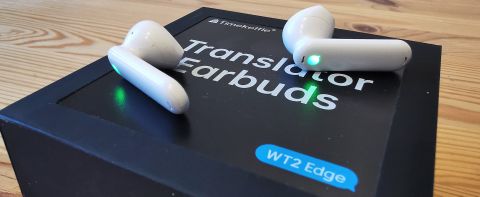TechRadar Verdict
A significant improvement over previous TimeKettle solutions, the speed and quality of the translation is impressive, as is the number of languages it can handle. But arbitrary decision to disable audio use seems odd.
Pros
- +
Lovely construction and design
- +
Translates 40 languages effectively
- +
Works offline at extra cost
- +
Suitable for group conferencing
Cons
- -
No music listening option
- -
Accessories need another box
- -
Expensive
Why you can trust TechRadar
We’re sure that when Gene Roddenberry created Star Trek that the translation system they talked about, but we never saw, was merely a plot mechanism to avoid hearing alien languages and needing subtitles.
But today, people expect that technology to exist and work, even if it's currently limited to interpreting the sounds made by other humans and the numerous languages we globally speak.
Asking a shopkeeper how much something costs in their language, and understanding the reply, can be accomplished with most mobile phones.
The limitations of this software feature are that it expects only one person to speak, and a data service must connect the device to the servers where the translation happens.
That’s fine for the odd vacation, but what if you’re trying to negotiate a sales deal with a foreign shop owner or establish a local franchise without the need to natively speak their language?
Then you might well consider using something like the TimeKettle WT2 Edge AI Translator Earbuds, providing built-for-purpose simultaneous translation between forty languages.
These aren’t a cheap option, but are they worth the investment?
Price and availability
TimeKettle WT2 Edge AI Translator Earbuds direct from the makers are $249.00 for the online translation version and $299 for the offline translation edition.
Those that want offline extra offline translations will need Fish card credits. 30 Fish coins cost $60, and 30 coins come with the WT2 Edge offline bundle to get you started.

Design
Before we talk about the WT2 Edge Translator Earbuds, we need to discuss the products that came before it. The WT2 Plus and M2 are prior designs that TimeKettle still sells, but that the WT2 Edge supersedes.
The WT2 Plus provided one-way simultaneous translation with some large ear pods that included earmuffs for prolonged wear and have a working life of about five hours.
These were meant only for translation use, and they cost $179 currently.
The M2 reduced the size of the Bluetooth earbuds further, making them easier to carry and wear, going from 10g of the WT2 Plus to only 5.4g per earbud. They also introduced dual beamforming microphones. The cost is an affordable $99, and these can be used to hear music or answer phone calls alongside their translation abilities.
The arrival of the WT2 Edge in the next step, matching the smaller weight of the M2, but allowing for bi-directional simultaneous translation, adding directional voice recognition and smart noise reduction, But, and this is a head-scratcher, going back to the original WT2 Plus limitation of not being able to be used for music or taking phone calls.

According to TimeKettle, the selling point of this design is that it’s the most sophisticated translation tool yet, promising greatly improved accuracy and speed of translation. However, they are also the most expensive earbuds they’ve so far made.
Out of the box, the first aspect of the WT2 Edge that struck us was how much smaller than the WT2 Plus, and M2 carry cases. The box is almost as small as the one that Apple provides its AirPods, which is tiny.
This case not only protects the ear pods in transit but also cleverly doubles as a charger.
While the pods only last three hours from a charge, the case can recharge them three times with an internal battery. That extends operating life to an effective 12 hours without needing to connect to a Type-C charger.
Charging time is 90 minutes, so it isn't possible to get 12 contiguous hours out of them.
From a design perspective, these are elegant design that isn’t radically different from expensive Bluetooth earbuds in form. However, they’re certainly not the same as Bluetooth earbuds in functionality.

In use
To operate the WT2 Edge hardware requires a mobile application available for Apple iOS and Google Android. It’s the same application irrespective of the TimeKettle hardware, and it works with the WT2, M2, WT2 Edge headphones and Zero speaker.
With the app running, it needs to be paired with the pods from within the app, as trying to connect them as conventional Bluetooth audio devices will not work.
We also noticed that they refuse to pair while sitting in the charging case, but the pairing is rapid if they’re outside the box or in your ears.
What’s slightly peculiar about the application is that it will then allow you to select one of four modes, having never asked what languages you intend to use it with.
By default, it sets one language to Chinese (Simplified) and the other to English. To switch this involves regressing through the application to a sub-menu where you can select the two languages to translate.
There are currently 40 different languages to choose from and 93 accents, including 20 specifically for Spanish dialects. For these to be translated live requires an internet connection, but offline translation is available for seven languages. More offline translations can be bought for Fish credits, each costing five credits.
The four modes available through the app are Simul, Touch, Speaker and Group Chat.
Simul mode, short for simultaneous, is designed for you to give one earbud to the person you wish to converse with. What’s most impressive about this solution is that it has no issue with people talking over each other, as we often do, and the conversation flows more easily.
For those uneasy with handing expensive hardware to complete strangers to use, Speaker mode allows you to retain the earbud, repurposing the phone to output to the foreign speaker. The pods still operate as microphones for picking up each side of the exchange, but it isn’t necessary to give the other party anything.

Touch mode is a variation on Simul, which allows the earbuds to be deactivated and reactivated by tapping the side of them. Where this would work best is when you are having a three-way conversation with another person that speaks the same language you do. Being able to selectively not translate everything said between you might be desirable and less confusing for the other foreign language speaker.
The final mode is Group Chat, a special function that’s designed for video conferencing scenarios where up to 30 people can come together for a meeting without the need for them to all speak a common language.
Using this feature is as simple as creating a group and inviting others to join it. Once the group is defined, translations are automatically converted into text chat for those that just want to follow what is being said.
For those companies willing to invest in a pair of these devices for all their staff, this could be a remarkably powerful facility. Though, depending on how technical the conversations become, it may have its limitations in translating typically spoken words and not the nuanced phrases and words of some sectors.
In general use, the translation is fast and mostly accurate if you speak clearly, and the pods are reasonably comfortable to wear for extended periods. Comfort is a personal experience, but as the product includes over-ear hooks and soft muffs, the designers have tried to make them accessible to most people.

Final verdict
The cost of these headphones is high, especially if you buy the Offline edition with the 30 Fish coins needed for extra offline translations.
In our tests, they delivered the ability to have a dynamic conversation without the staccato nature of some translation technology. It’s human nature to talk over people, especially when you’ve guessed where their sentence is going, and the bi-directional nature of the WT2 Edge works fine even with a significant amount of cross-talking.
Other than the price, we’ve got two issues with these, and the first is the curious choice to regress the design to not work as standard headphones.
Should you be translating and receive a call, you’re forced to take that on the phone rather than having a pause-to-call option, which could be very inconvenient.
The TimeKettle explanation is, “WT2 Edge is a professional voice translator and does not support functions such as listening to music and making phone calls “. That logic makes little sense since the TimeKettle M2 are wireless translation devices but can also double as headphones, so why not the WT2 Edge?
There might be a perfectly credible technical reason this limitation exists, but TimeKettle chose not to share that in their product FAQ.
Our second issue is that while the box is small and easy to carry, nothing is provided to hold all the other accessories like the hooks, earmuffs, and charging cable. Even if you don’t use the hooks and muffs, there is nowhere to stow the charging cable. At this price, including a box that holds the whole solution that isn’t cardboard would not seem an unreasonable expectation.
Those points aside, as translation devices go, the WT2 Edge is impressive in use, as responding within seconds to a foreign speaker in their language makes for a less stressful travelling experience. What’s missing is some tools that would allow them to be used as a training aid for those learning a non-native language. Maybe TimeKettle thinks that encouraging others to speak multiple languages isn’t in their commercial best interests.
Overall, if these costs $199 or ideally less, then we’d more strongly recommend them. But headphones that cost a minimum of $249 and you can’t listen to music using them aren’t a bargain.
But conversely, these are the most impressive automatic translation headphones we’ve yet used and could easily be worth much more to anyone who regularly travels for business purposes.
Mark is an expert on 3D printers, drones and phones. He also covers storage, including SSDs, NAS drives and portable hard drives. He started writing in 1986 and has contributed to MicroMart, PC Format, 3D World, among others.

The latest Nintendo Switch firmware update fixes an issue that stopped some players being able to connect to Wi-Fi

Wear OS 5: what we want to see, and all the leaks so far

The obscure little PC that wanted to be a big NAS — super compact Maiyunda M1 doesn't cost that much, offers up to 40TB SSD storage, runs Windows and has 4 Gigabit Ethernet ports

